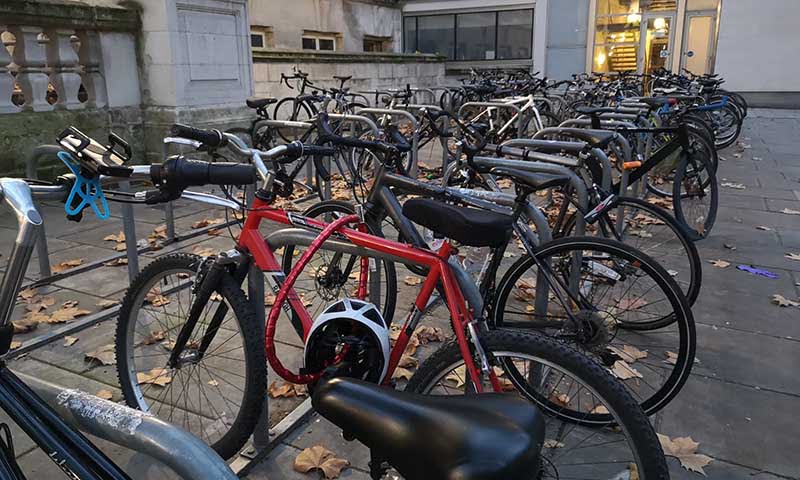This guide is designed to help you quickly improve your level of security and reduce the chances of your bicycle being stolen, whatever bike it is and wherever you lock it up.
It is broken down into 5 main elements: Where you lock your bike, what you lock it to, what you lock it with, how you lock it and what you’re locking up.
Table of Contents
Where you lock your bike
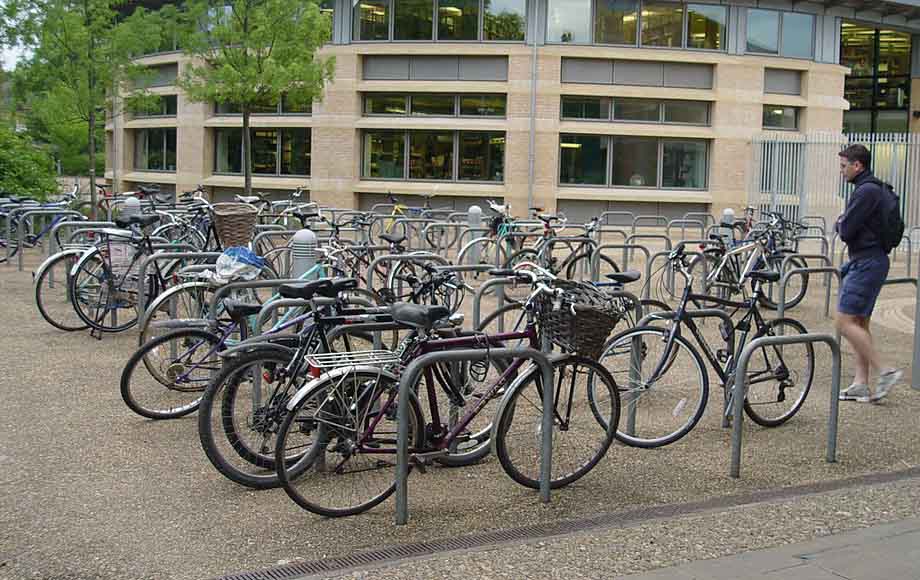
Preventing your bike being stolen isn’t just about the quality of the lock you use.
As they say in the house-hunting world: “Location, location, location”.
It (almost) goes without saying: even if you’re just nipping in to your local coffee shop to grab a flat white, if you anticipate leaving your bike unattended, you should lock it up to prevent theft.
With security fitted, a thief needs to utilise tools to get through the lock.
However one of the first layers of security is not to lock your bike in a place where a thief can operate unseen.
I wouldn’t lock my bike around the back of a shopping centre, tucked away by the wheelie bins in the loading bays; I’d rather lock it right outside the public entrance.
Wherever you lock your bike, look for CCTV coverage; banks and supermarkets frequently have CCTV and sometimes security guards. Those guards are unlikely to jump out and save your bike but they’ll deter a chancer in the first place.
Basic Location Locking Tips
- Busier areas are often better at deterring a thief
- Find a location where your bike isn’t the only one there because there is safety in numbers.
- If you plan to lock your bike up at night, pick a location with good lighting where a thief would have a hard time operating without being seen.
- Try not to lock your bike in the same location every day.
The One Place I Never Lock My Bike
I never lock my bike in any ‘secure’ parking areas. That’s a private car-park to you and I. They might give you a sense that it’s safer but that security-guard on the barrier is busy watching the football on his iPhone. Everyone parking their is busy with shopping or trying to stop their kids being run over.
They’re often not that well lit. The bike racks here are usually tucked away in the corner where no-one else goes. Thieves can operate here with impunity, and they know that because these locations are seen as ‘secure’ people use less security. Big no from me.
What you lock it to
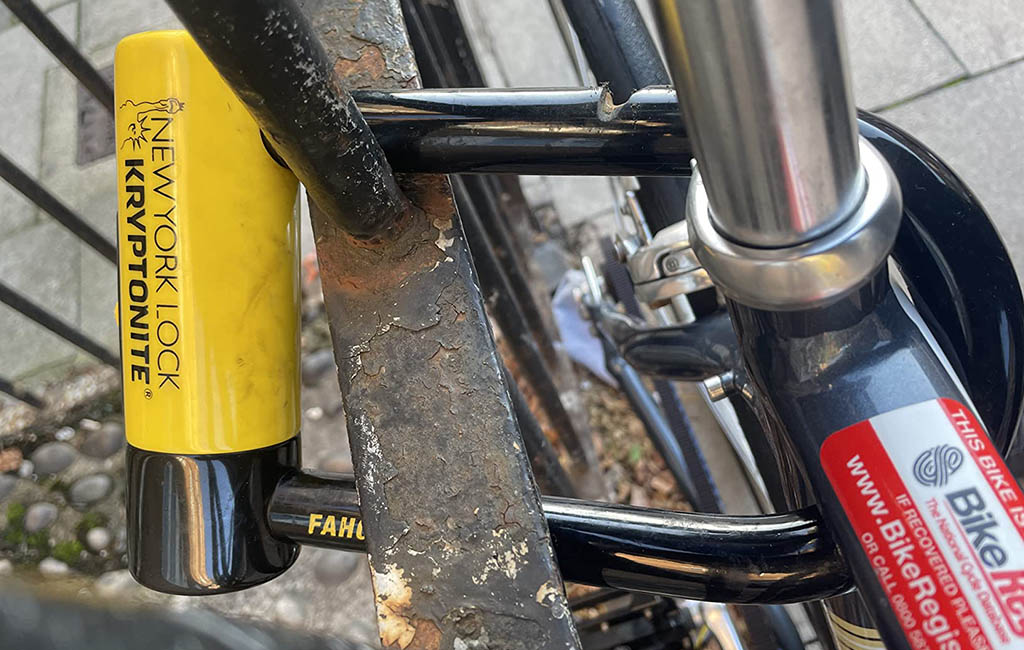
It’s no good having a Sold Secure Gold-rated lock and then locking your bike to a flimsy railing. The railing will get cut and your bike will be gone.
Local councils are pretty good these days at providing decent secure bike posts in town centres.
If you can’t find a proper bike rack, lock it to something solid. Railings are OK but thin ones can be cut quite easily. Street signs are a good choice too. However, I wouldn’t leave my bike attached to these overnight, as your bike can be lifted up-and-over a street sign and railings ground away in seconds.
The Sheffield Stand
The “Sheffield Stand,” which is recognisable by its U-shaped or staple-like appearance, is the type of bike stand I look for. It’s the most common one you’ll see in a town-centre location. You should be able to securely lock the frame and both wheels to this support.
It isn’t unknown for thieves to cut these stands but that is rare, so just have a quick look before you lock up.
I always try and locate my bike in the middle of these types of bike rack. That way it’s fairly well obscured by other bikes in the rack, so a passing thief won’t easily be able to spot your bike from a distance.
What you lock it with
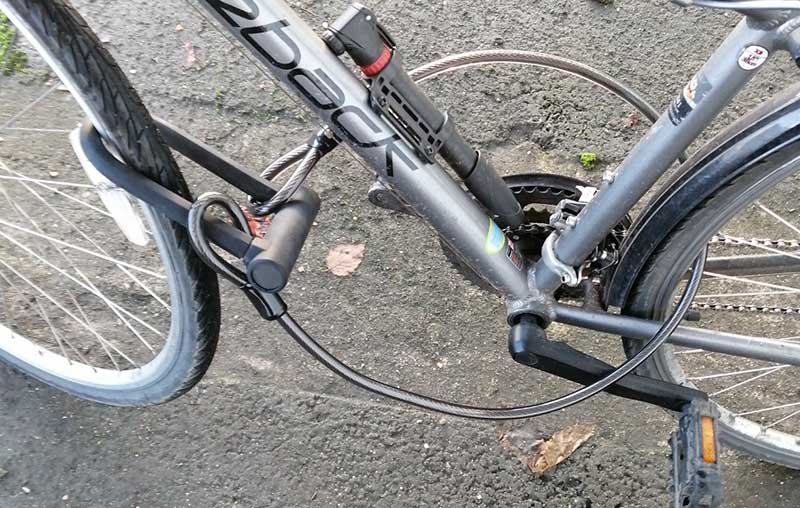
What you use to lock your bike should depend on a few factors. I’ve written a guide that explains why the most common lock I use is a simple £20 cable lock. Most other guides would tell you to never use a cable lock – but it works for me.
If you’re buying one piece of security, it doesn’t really matter whether it’s a bicycle security chain or a bike U-lock or a folding lock. What matters is that you buy a lock that you are prepared to use every day. So, it has to be portable (i.e. you are prepared to carry it), it should be Sold Secure rated and it should be the most expensive lock you are prepared to shell out for.
Forget those guides that say you should spend 10% or 15% of your bike’s value on a lock. That is nonsense. A thief doesn’t stand there looking at bikes and locks, working out who’s got the worst bike to lock ratio. They’ll pinch whatever’s easiest and easiest isn’t just about the physical security and how quickly they can get it off (although that is part of it).
Easiest is about their success ratio. So, stealing a £200 bike from a quiet location with a decent lock might appeal to them more than a £1,000 bike in a busy location with two decent locks. They want to steal bikes, they don’t want to get caught.
If your bike is stolen, you’ll probably never see it again. Think about that when you’re agonising over whether you should spend £30 or £70 on a bike lock. The grief involved in a bike theft is huge. The cost is also high.
Better or more security is always a good option.
How you lock it
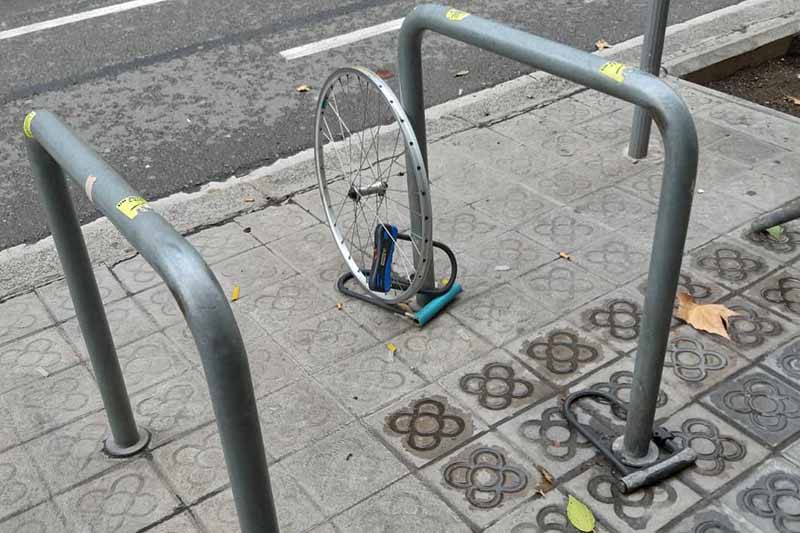
This (almost) goes without saying but you should always put your lock through a part of your bike’s frame. Don’t just lock the wheels.
Here are my simple tips on how to use your security to reduce the chances of your bike being stolen.
- Always lock the frame to the secure your bike (don’t just lock the wheel!). If you can, lock the frame and front wheel as front wheels are easier to remove.
- Keep the lock as high as possible and away from the ground. If your lock is sat on the ground, thieves can smash it with a hammer or get more leverage with their bolt-croppers.
- Avoiding locking around the top tube. This can give the thief a ‘surface’ to work from, i.e. if they are using an angle grinder they can keep the lock steady by resting it on your top tube.
- Make it hard to access. If you are using a D-lock, occupy as much of the inside space as you can to make the lock as challenging to open as possible, so the lock can’t be prised apart, etc. If you have a long chain, wrap the slack around the bike so the thief can’t easily yank or twist the lock.
Two locks are always better than one. When I’m leaving my bike in town for an hour or so, I use a heavy-duty folding lock around the frame and front wheel and a basic cable lock around the rear wheel.
It’s not a 100% theft-proof (nothing is) but a thief doesn’t want to loiter around a bike. Two locks might require more time, more tools, more intent.
Couple that to the fact the bike’s in the middle of a bike rack, on a high footfall area and I’m confident I’m using good real-world protection against your average bike thieving scrote.
What you’re locking up
We can’t all afford to have two bikes but if you’re parking your £3,000 ebike in your local town centre you’re already at a higher risk. The same goes for racing bikes and branded bikes like Bromptons.
There are types of bikes that thieves prefer. Glitzy-looking race bikes will appeal over a dull-looking touring bike with a basket. Brands like Brompton are a big target here in London.
While a team of bike thieves might not win a pub quiz, they are well versed in their game and they know what they can easily move on.
The things they’re thinking about are:
- How easy is that bike to steal?
- What are the chances of me being caught?
- How much will I get for it?
- How easy will I be able to shift it?
Therefore, if you have a lovely racing bike that comes out a few times a year and you also use it when you nip into town, I’d suggest buying an old shopping bike instead. You could probably get one for not much more than the price of a good lock.
How to lock your bicycle infographics
We’ve gathered together a bunch of really useful infographics that help explain some of the best bicycle locking techniques.
If you lock your bicycle properly, you’ll massively improve the effectiveness of your lock, whether it’s a £20 D-lock or a £200 security chain.


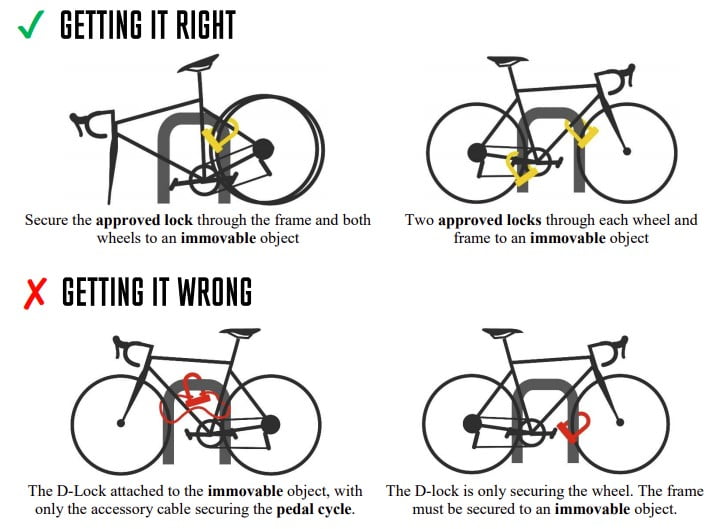

Sources
Thanks to the following website that helped us research and publish this guide to the best ways to lock your bicycle:
